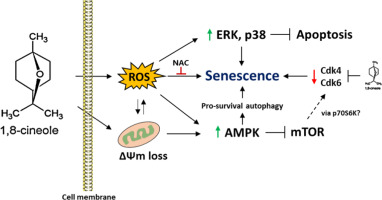Our official English website, www.x-mol.net, welcomes your feedback! (Note: you will need to create a separate account there.)
1,8-Cineole promotes G0/G1 cell cycle arrest and oxidative stress-induced senescence in HepG2 cells and sensitizes cells to anti-senescence drugs.
Life Sciences ( IF 6.1 ) Pub Date : 2020-01-08 , DOI: 10.1016/j.lfs.2020.117271 Boris Rodenak-Kladniew 1 , Agustina Castro 2 , Peter Stärkel 3 , Marianela Galle 2 , Rosana Crespo 1
Life Sciences ( IF 6.1 ) Pub Date : 2020-01-08 , DOI: 10.1016/j.lfs.2020.117271 Boris Rodenak-Kladniew 1 , Agustina Castro 2 , Peter Stärkel 3 , Marianela Galle 2 , Rosana Crespo 1
Affiliation

|
AIMS
1,8-Cineole is a plant-derived monoterpene and a major constituent of Eucalyptus essential oil. Previously, we demonstrated that 1,8-cineole inhibited hepatocellular carcinoma (HCC) HepG2 cell growth. However, the underlying mechanisms remain unknown. Here, we evaluated the mechanisms of action of 1,8-cineole and the potential benefits of its combination with anticancer compounds harboring "anti-senescence" properties in HepG2 cells.
MAIN METHODS
Cell viability was determined by the MTT assay. Cell cycle was assessed through flow cytometry (FC) and western blot (WB). Senescence was determined by the SA-β-galactosidase assay, and apoptosis by caspase-3 activity, WB, and TUNEL. MAPKs (ERK, JNK, and p38), AMPK, and Akt/mTOR were analyzed by WB. Reactive oxygen species (ROS) and mitochondrial membrane potential (ΔΨm) were evaluated by FC and fluorescence microscopy.
KEY FINDINGS
1,8-Cineole inhibited cell proliferation by promoting G0/G1 arrest. While 1,8-cineole was unable to trigger apoptosis, it induced cellular senescence. 1,8-Cineole promoted ROS production, ΔΨm depolarization, AMPK, ERK, and p38 activation and mTOR inhibition. Antioxidants, like N-acetyl-L-cysteine and vitamins, prevented HepG2 cell growth inhibition and senescence induced by 1,8-cineole. Pre-incubation with 1,8-cineole sensitized HepG2 cells to the anti-senescence compounds, quercetin, simvastatin, U0126, and SB202190. Combinations of 1,8-cineole and each compound synergistically inhibited cell viability, and combined treatment with 1,8-cineole and simvastatin induced apoptosis.
SIGNIFICANCE
1,8-Cineole induces G0/G1 arrest and senescence in HepG2 cells through oxidative stress and MAPK, AMPK, and Akt/mTOR pathways, and sensitizes cells to anti-senescence drugs, suggesting that 1,8-cineole has potential as an antineoplastic and adjuvant compound in combination with anti-senescence drugs in HCC therapy.
中文翻译:

1,8-Cineole促进HepG2细胞中的G0 / G1细胞周期停滞和氧化应激诱导的衰老,并使细胞对抗衰老药物敏感。
AIMS 1,8-Cineole是植物来源的单萜,是桉树精油的主要成分。以前,我们证明了1,8-桉树脑抑制了肝细胞癌(HCC)HepG2细胞的生长。但是,基本机制仍然未知。在这里,我们评估了1,8-桉树脑的作用机理及其与HepG2细胞中具有“抗衰老”特性的抗癌化合物联合使用的潜在益处。主要方法通过MTT测定法测定细胞活力。通过流式细胞术(FC)和蛋白质印迹(WB)评估细胞周期。通过SA-β-半乳糖苷酶测定确定衰老,并通过caspase-3活性,WB和TUNEL确定细胞凋亡。通过WB分析MAPKs(ERK,JNK和p38),AMPK和Akt / mTOR。通过FC和荧光显微镜评估活性氧(ROS)和线粒体膜电位(ΔΨm)。主要发现1,8-Cineole通过促进G0 / G1阻滞抑制细胞增殖。虽然1,8-桉树脑不能触发细胞凋亡,但它诱导细胞衰老。1,8-Cineole促进了ROS的产生,ΔΨm去极化,AMPK,ERK和p38激活以及mTOR抑制。N-乙酰-L-半胱氨酸和维生素等抗氧化剂可防止1,8-桉树脑诱导的HepG2细胞生长抑制和衰老。与1,8-桉树脑致敏的HepG2细胞预温育以抗衰老化合物槲皮素,辛伐他汀,U0126和SB202190。1,8-桉树脑和每种化合物的组合可协同抑制细胞活力,并与1,8-桉树脑和辛伐他汀联合治疗可诱导细胞凋亡。意义1
更新日期:2020-01-09
中文翻译:

1,8-Cineole促进HepG2细胞中的G0 / G1细胞周期停滞和氧化应激诱导的衰老,并使细胞对抗衰老药物敏感。
AIMS 1,8-Cineole是植物来源的单萜,是桉树精油的主要成分。以前,我们证明了1,8-桉树脑抑制了肝细胞癌(HCC)HepG2细胞的生长。但是,基本机制仍然未知。在这里,我们评估了1,8-桉树脑的作用机理及其与HepG2细胞中具有“抗衰老”特性的抗癌化合物联合使用的潜在益处。主要方法通过MTT测定法测定细胞活力。通过流式细胞术(FC)和蛋白质印迹(WB)评估细胞周期。通过SA-β-半乳糖苷酶测定确定衰老,并通过caspase-3活性,WB和TUNEL确定细胞凋亡。通过WB分析MAPKs(ERK,JNK和p38),AMPK和Akt / mTOR。通过FC和荧光显微镜评估活性氧(ROS)和线粒体膜电位(ΔΨm)。主要发现1,8-Cineole通过促进G0 / G1阻滞抑制细胞增殖。虽然1,8-桉树脑不能触发细胞凋亡,但它诱导细胞衰老。1,8-Cineole促进了ROS的产生,ΔΨm去极化,AMPK,ERK和p38激活以及mTOR抑制。N-乙酰-L-半胱氨酸和维生素等抗氧化剂可防止1,8-桉树脑诱导的HepG2细胞生长抑制和衰老。与1,8-桉树脑致敏的HepG2细胞预温育以抗衰老化合物槲皮素,辛伐他汀,U0126和SB202190。1,8-桉树脑和每种化合物的组合可协同抑制细胞活力,并与1,8-桉树脑和辛伐他汀联合治疗可诱导细胞凋亡。意义1



























 京公网安备 11010802027423号
京公网安备 11010802027423号